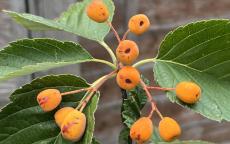Whitebeam trees
Whitebeams are part of the Sorbus group, closely related to the Rowans / Mountain Ash.
John Bond
An unusual species of Sorbus, the leaves are particularly attractive for their white undersides.- Fruit colour: Brown
- Awards: RHS AGM (current)
Sorbus hemsleyiJohn Mitchell
John Mitchell is a popular whitebeam, notable for its large white-green leaves.- Fruit colour: Brown
- Awards: RHS AGM (current)
Sorbus x ariaLemon Drop
Lemon Drop is a small whitebeam tree, with the characteristic white undersides to its leaves. As the name suggests, the fruitlets are bright yellow.- Fruit colour: Yellow
Sorbus folgneriMajestica
Majestica is a classic large Whitebeam, with silvery-grey leaves contrasting in autumn with clusters of orange-red berries.- Fruit colour: Orange / Red
- Awards: RHS AGM (current)
Sorbus ariaRed Bird
Red Bird features bright white flowers, orange / red fruits and good autumn leaf colours. It has a wider climate range than other rowans.- Fruit colour: Orange / Red
Sorbus alnifoliaSorbus hedlundii
A little-known whitebeam species, it features the classic downy grey-green leaves, and russeted fruitlets in autumn.- Fruit colour: Brown
Sorbus hedlundiiSorbus japonica
An upright rowan with large oval leaves and attractive autumn colours and large red fruitlets.- Fruit colour: Red
Sorbus japonicaSorbus wardii
A little-known Whitebeam from the Himalayas, featuring large silver-green leaves and yellow-orange berries.- Fruit colour: Yellow / Orange
Sorbus wardiiWild Service Tree
A large traditional Rowan tree, native to England.- Fruit colour: Brown
Sorbus torminalis
How to choose Whitebeam trees
Whitebeams are part of the Sorbus family, and closely related to rowans. However whilst rowans usually have highly feathered leaves, whitebeams have regular-shaped leaves - often with attractive veins which are white on the undersides. Like rowans, whitebeams produce clusters of small flowers in late spring, followed by abundant (usually red) fruitlets. The main attraction is the orange and red colours of the autumn foliage, but whitebeams have a stately presence throughout the year.
Whitebeams are very easy to grow, and tolerate a wide range of soil conditions, including chalky soils and exposed situations.
Many of our whitebeam trees are grafted on to Sorbus intermedia rootstocks (also known as Swedish Whitebeam). We also sometimes use Sorbus aucuparia (the common Rowan). This helps give a consistent size and form.



